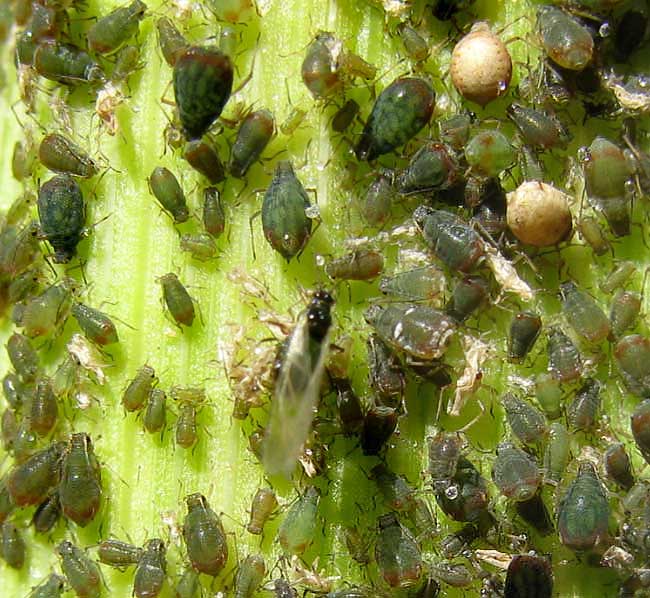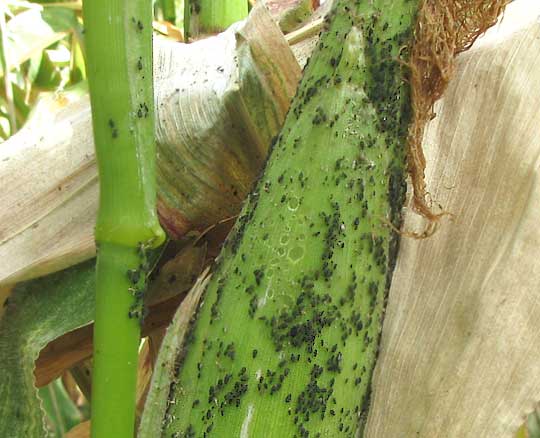Excerpts from Jim Conrad's
Naturalist Newsletter

from the October 4, 2009 Newsletter, issued from the Siskiyou Mountains west of Grants Pass, Oregon:
APHIDS ON THE CORN
A few of our garden corn plants are heavily infested with aphids. You can what that looks like below.

A view of the aphid world beneath a corn blade, showing aphids of all sizes, most unwinged but one with wings, some discarded exoskeletons, and a couple of large, round, brown ones can be seen at the page's top.
It looks like two species are shown there mingling. The most abundant one, with pear-shaped bodies, are probably Birdcherry Oat Aphids, RHOPALOSIPHUM PADI. A few, such as the larger one to the left of the winged one in the picture's center, display boxy thoraxes (the middle body segment) and look more like aptly named Corn Leaf Aphids, RHOPALOSIPHUM MAIDIS.
The Birdcherry Oat Aphid's common name reveals something about the species. Birdcherry is a kind of Eurasian cherry tree, so we learn that this aphid species is invasive in North America. The Oat in the name refers to the oat plant, and that points out that during the Birdcherry Oat Aphid's life cycle it alternately lives on two different plants -- winters on cherry trees and closely related species, and summers on oat plants and closely related grass species (such as our corn).
The Birdcherry Oat Aphid egg phase takes place on buds of cherry-related trees in the winter. When eggs hatch in the spring the larvae, normally all females, form colonies on the upper sides of leaves and in blossoms. Three to five generations occur there, the average female producing about 70 offspring. With warmer weather winged females are produced who migrate to a Grass-Family plant such as corn where they produce generation after generation of females. Toward the end of summer winged males begin to be born and these together with winged females migrate back to their cherry-related host trees where more males and females are produced. They sexually produce eggs that are laid in bud axils on young branches, and the life cycle starts over.
This alteration of host species, with the hosts being very different plants, and males and winged individuals being produced only when they're needed, is typical of other aphid species, though of course usually other species employ different hosts.
from the October 4, 2009 Newsletter, issued from the Siskiyou Mountains west of Grants Pass, Oregon:
APHID MUMMIES
In the picture of many aphids on the bottom of a corn blade at the top of the opage, do you see at the top, right the two large, tan-colored, spherical-bodied aphids? Those are dead aphids called "mummies."
Aphid mummies result when a female parasitic wasp inserts an egg into the aphid. When the egg hatches the larva feeds on the aphid's internal body parts, eventually killing and emptying the "skin" or exoskeleton. Often you can find aphid mummies with neat holes in their tops or sides, even with the holes' "lids" still attached to one side like the top of an open tin can. This is where the parasitic wasp that has developed inside the aphid has escaped.
Though I've seen aphid populations where nearly every mummy had such holes, with a handlens I checked dozens of such mummies on our corn plants but they all showed only dark spots on their interior side walls, which I'm guessing were the parasitic wasps' pupae from which later the adult wasps will emerge and cut their ways from the aphid's shell.